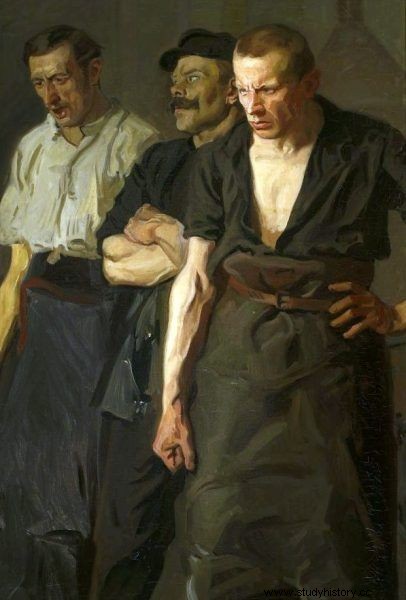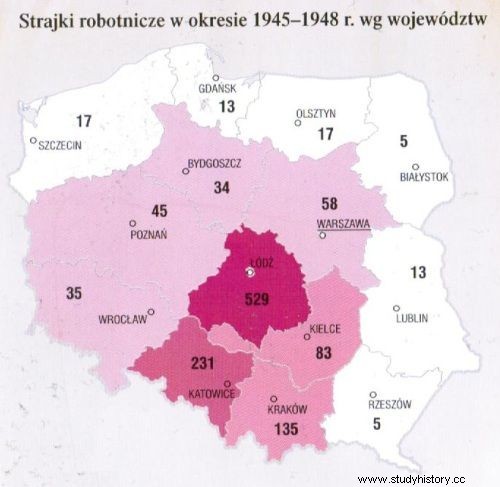The popular opinion was that social strikes in Poland did not start until June 1956 - previously Poles, held briefly by Stalin and Bierut, were reportedly afraid of going out into the streets. There is not much truth in that. Well, the PRL propaganda did a great job, and no one corrected it later. In fact, by the time the 1956 protests took place, a huge wave of strikes had swept across the country. The biggest one until August '80!
The leaders of the one and only party of the right must have had a terrible headache from this wave. After all, a strike is a form of class struggle, and in a country of people's democracy this struggle should no longer exist. While formally permitted, this kind of objection was extremely poorly viewed by the authorities. The new reality was to be the promised land of the working people of towns and villages, and they brazenly rebelled!
The party believed that workers could strive to improve their living conditions by means of negotiations and agreements, and that strikes should only take place in agreement with the trade unions. There was only one snag - the latter (especially their leadership and senior ranks) were completely overrun by communists, who clearly did not like the rebellion.
However, let us not think that the authorities were completely against the strikes. Indeed, one should strike against ... too loud and solemn celebration of the 3rd May holiday, or definitely for the enthusiastic reception of this nasty Santa Claus in some places.

According to the communists, the new reality was to be the promised land of the working people. Meanwhile, workers' strikes broke out every now and then. Stanisław Lentz's painting "Strike" (source:public domain).
Such speeches were organized in 1946:at workplaces, under the inspiration of the authorities, protests against young people who took part in the celebration of the celebration of the Constitution were held. Anyway, it was also necessary to protest against the re-privatization. If this were to take place in full, the state would hurt your wallet extremely badly. But state-inspired strikes were just a drop in the ocean. The workers quickly followed suit and they started fighting for theirs!
To protest! Against the people's power!
According to the statistical data quoted by Witold Sienkiewicz in the book "Poland since 1944. The Latest History", in the years 1945-1948 roughly one thousand two hundred strikes broke out in Rzeczpospolita . In other words, people rioted almost every day somewhere in the country! Of these, three quarters were speeches to improve workers' lives.
The remaining strikes were undertaken in solidarity with other social groups, e.g. with the repressed pupils and students, workers fired from work or in defense of former factory owners. 340,000 workers protested in 1946 alone .
Most of the speeches focused on three voivodeships:Łódzkie, Śląskie and Kraków. About 78% of all protests took place there. Such an intensity of strikes in a small area was related to the fact that in the first period after the war, this is where the industrial basin of Poland was located. It was inhabited by workers from pre-war factories, and their environment until 1947 was rather homogeneous and consolidated. The most protests took place in Łódź .

Map from the book by Witold Sienkiewicz entitled "Poland since 1944" (Demart 2011).
The factory workers there had many years of experience, they knew each other and trusted each other. Interestingly, strikes were most often taken not by the poorest workers, with the lowest industrial and social position, but by those with the highest qualifications, with the longest seniority and experience, with a decent economic status. Perhaps it was due to greater political awareness and self-esteem?
Workers working in the mining and textile industries went on strike most often, they constituted more than half of the protesters in general. These industries had the largest workplaces, which made it easier to organize a large strike.
The party could not perceive these speeches except through the prism of… reactionary activity. Yes, ladies and gentlemen, the workers were thrown into the same sack as even the fascists ! The rulers had to somehow deal with the "politics" of the dissatisfied actions. Methods used later for many years were born quickly…
Prevention is better than combating

At the beginning, it was necessary to break up the consolidated environment of factory workers, coming from families with working-class traditions and considerable political awareness. The way to do this was to support people coming to industrial cities from smaller centers and from the countryside. These people, with low technical culture and very low qualifications, were unable to get along with experienced workers, thus weakening the unity of the plants.
The heterogeneous crews were unable to create a common front directed against the factory management or the state authorities. Thus the threat of effective strikes vanished.
In order to better protect themselves against strikes, company party cells were organized and helpful informants were found. The norm was that in each plant at least 1% of employees should work for the security services at the same time.
In March 1948, the network of agents and informants numbered over 15,000 people . Apparently 60% of them chose this service for patriotic reasons, the rest were recruited thanks to compromising materials in the possession of the security or through bribery.
The Ministry of Public Security had a lot of work to do with strikes. Much effort was put into suppressing them, mainly by organizing rallies against the strikers and arresting the most active participants.
However, it is better to prevent than to deal with it later! After a few years, workers were quite successfully persuaded to express their views. Most interestingly, it was done so successfully that the strikes of the 1940s completely disappeared from history . There were over a thousand of them, and nowadays they are not even mentioned in school textbooks ...
Source:
- Witold Sienkiewicz, Poland since 1944. Latest history , Demart 2011.
